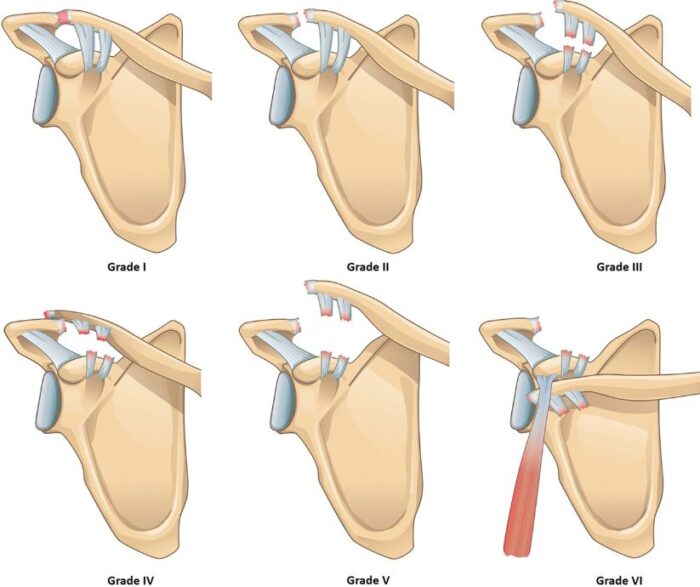Acromioclavicular separation is a common injury among active sports enthusiasts. Here’s how to learn more about this injury, the different types that exist, and how physiotherapy can help you come back stronger than ever!
What is acromioclavicular separation?
Imagine yourself in the middle of a rugby match, the ball in the air, victory within your grasp. But then an opponent lands a direct blow on your upper acromion. Ouch! The acromioclavicular separation is born. The acromioclavicular ligaments are affected. In the event of very powerful impact, the coracoclavicular ligaments may also be affected.
The most common sports for this injury:
If you’re the type to get into intense sports like rugby, field hockey, soccer or mountain biking, then you’ve got an idea of what it’s like to struggle with acromioclavicular separation. These sports, with their fierce contact and merciless falls, can put your shoulder to the test.
What are the types of acromioclavicular separation and how do they differ?
Type 1: This is a simple sprain of the acromioclavicular ligament, without any disturbance of the coracoclavicular ligament.
Type 2: This is a little more serious. The acromioclavicular joint is disrupted, with a sprain of the coracoclavicular ligament. A small gap forms in the joint, but the ligaments remain intact.
Type 3: Things get more intense. The acromioclavicular and coracoclavicular ligaments are affected. This causes separation of the acromioclavicular joint. As a result, the shoulder complex moves downwards.
Type 4: The clavicle is displaced backwards, into the trapezius fibers. The acromioclavicular and coracoclavicular ligaments are affected. The deltoid and trapezius fibers detach from the distal clavicle.
Type 5: The clavicle separates vertically from the scapula, creating a gap between the two parts.
Type 6: This is a real blow where the clavicle decides to slip under the coracoid process. In these situations, surgery is often necessary to put everything back in order. But physiotherapy can also play an important role in this healing adventure.
source image : Radiological Society of North America
How does physiotherapy help with this injury?
In physiotherapy, our main goal is to relieve the symptoms. That is, to get rid of the unbearable pain and deflate the inflammation. We also want to restore normal shoulder movement. And to achieve this, we need to restore harmony between the scapulothoracic joint and the muscles surrounding it.
“Imagine this acromioclavicular separation as a concert where all the musicians play solo, without coordination. Our job is to become the conductor and ensure that each musician plays his or her part at the right time, creating a magnificent symphony. And that symphony is your shoulder finding its natural rhythm, without false notes.” – Dominic Baillargeon
Special exercises will be given to strengthen the shoulder and clavicle muscles. The shoulder will regain its muscular balance, like a tightrope walker regaining his confidence on the wire. But the physio’s help doesn’t stop there. The therapist will draw up a new action plan to restore the shoulder’s full mobility and strength.
Surgery or no surgery?
There are different degrees of severity for an acromioclavicular separation. For types 1 to 3, we can recover with our physio expertise. But for types 4 to 6, we may need to team up with surgeons to work our way to recovery.
In short, with physiotherapy, we’ll direct your shoulder orchestra, rebalance the muscles and guide the patient back to mobility and strength. If you have any further questions, please don’t hesitate to ask. We’re here for you, ready to accompany you on this healing adventure.


